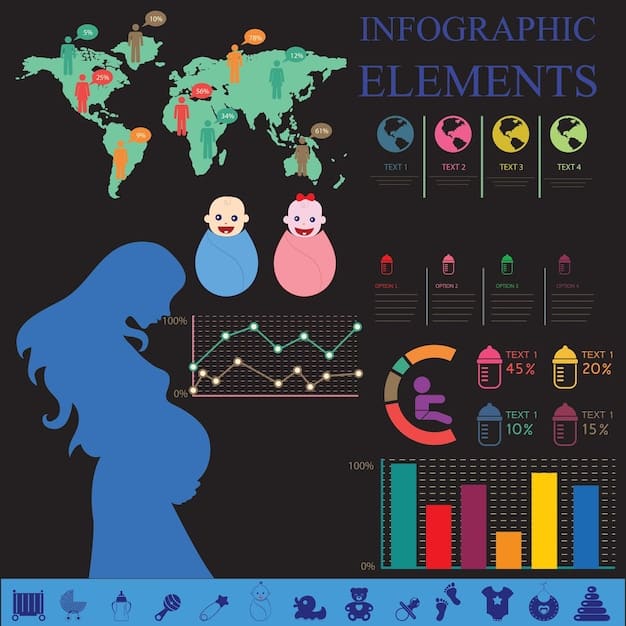Decoding Baby Cries: Understand What Your Baby Is Trying to Tell You

Decoding baby cries involves recognizing different sounds, pitches, and patterns to understand whether your baby is hungry, tired, in pain, or simply needs a diaper change, allowing for prompt and effective responses to ensure their comfort and well-being.
Have you ever wondered what your baby is trying to tell you through their cries? Decoding baby cries: understanding what your baby is trying to tell you can feel like a mystery, especially for new parents. But with a little knowledge and practice, you can learn to distinguish between different types of cries and respond effectively to your baby’s needs.
The Basics of Baby Cries
Babies cry for various reasons, and understanding these reasons is the first step in effective communication. It’s crucial to realize that crying is a baby’s primary way of expressing needs and emotions, from hunger and discomfort to the need for attention.
Recognizing the basic types of cries can help you respond more quickly and appropriately. This also reduces frustration for both you and your baby, creating a more harmonious environment.
Why Do Babies Cry?
Babies cry as a form of communication. It’s how they tell you they need something. Here are some common reasons:
- Hunger: Often starts as a quiet whimper and escalates to a frantic cry.
- Discomfort: Could be due to a wet or dirty diaper, clothing that’s too tight, or being too hot or cold.
- Tiredness: Can sound like fussing or whining, and may be accompanied by yawning or rubbing eyes.
- Pain: Usually a sudden, high-pitched, and continuous cry.
Understanding these foundational reasons can lead to more effective caregiving.

Different Types of Baby Cries and Their Meanings
Each type of cry has its unique characteristics. Learning to differentiate between them can significantly improve your ability to meet your baby’s needs. While no two babies are exactly alike, there are general patterns you can observe.
Here’s an overview of the common cries and what they typically signify.
The Hunger Cry
A hunger cry usually starts softly and rhythmically, gradually becoming louder and more persistent. It may also be accompanied by rooting reflexes, such as turning their head and opening their mouth as if looking for a nipple or bottle.
Listen for the following cues:
- Starts softly and rhythmically
- Gradually increases in intensity
- Accompanied by rooting reflexes
The Pain Cry
The pain cry is often sudden, high-pitched, and continuous. It may come in sharp bursts and is generally more intense than other cries. This type of cry typically indicates that your baby is experiencing discomfort or pain that needs immediate attention.
Key characteristics include:
- Sudden and high-pitched
- Continuous and intense
- May come in sharp bursts
Decoding the Colic Cry
Colic is characterized by intense, inconsolable crying that lasts for several hours, typically in the late afternoon or evening. These episodes can be particularly distressing for parents, who may feel helpless in their attempts to soothe their baby.
Understanding the signs and potential causes can help you provide the best support for your little one.
What is Colic?
Colic is generally defined as crying for more than three hours a day, more than three days a week, for at least three weeks in an otherwise healthy baby. While the exact cause of colic is unknown, there are several theories, including digestive issues, gas, overstimulation, or even temperament.
Common indicators include:
- Intense crying episodes lasting several hours
- Occurring typically in the late afternoon or evening
- Baby may clench fists, draw knees to chest, or arch their back
It’s vital to consult with your pediatrician to rule out any underlying medical conditions.
Soothing Techniques for Different Cries
Once you’ve deciphered what your baby is trying to communicate, the next step is to apply the appropriate soothing techniques. Different cries may require different approaches, so it’s essential to tailor your response to your baby’s specific needs.
Here are some strategies you can use:
Responding to Hunger Cries
If the cry indicates hunger, offer breast milk or formula. Ensure you are feeding at regular intervals and watch for early hunger cues before the crying begins, such as lip-smacking or bringing hands to mouth.
Dealing with Discomfort Cries
Check your baby’s diaper and change it if necessary. Ensure their clothing isn’t too tight or irritating. Adjust the room temperature if they seem too hot or cold.

Understanding Sleep Cries
Cries associated with sleep can often be subtle and easily misinterpreted. Recognizing these cries can help you establish better sleep routines and ensure your baby gets the rest they need.
Sleep-related cries can be categorized as either overtired cries or cries indicating a need for assistance in falling asleep.
Overtired Cries
Overtired cries often sound fussy or whiny. Your baby may also rub their eyes, yawn, or become restless. Addressing these cries promptly can prevent them from escalating into more intense crying fits.
Assistance Cries
Some babies cry out briefly as they transition between sleep cycles or need assistance falling asleep. These cries are usually softer and less urgent than hunger or pain cries and may simply indicate a need for comfort.
When to Seek Professional Help
While most baby cries can be addressed with simple care and attention, there are instances when seeking professional medical advice is necessary. Persistent, inconsolable crying could be a sign of an underlying medical issue that needs to be addressed.
Knowing when to consult a healthcare professional can ensure your baby receives the care they need in a timely manner.
Signs That Warrant a Doctor’s Visit
If your baby’s crying is accompanied by any of the following symptoms, it’s essential to seek medical advice:
- Fever (100.4°F or higher)
- Vomiting or diarrhea
- Lethargy or decreased responsiveness
- Difficulty breathing or changes in skin color
Trusting your instincts and seeking professional help when necessary can provide peace of mind and ensure your baby’s well-being.
| Key Point | Brief Description |
|---|---|
| 😫 Identifying Hunger | Starts soft, rhythmic, intensifies with rooting reflexes. |
| 🤕 Recognizing Pain | Sudden, high-pitched, continuous, and intense cries. |
| 😩 Understanding Colic | Inconsolable crying lasting for hours, often in the evening. |
| 😴 Addressing Tiredness | Fussing or whining, often with yawning or eye-rubbing. |
Frequently Asked Questions
▼
A hunger cry typically starts softly and may be rhythmic, gradually increasing in intensity. Watch for other cues like rooting or bringing hands to the mouth.
▼
Try gentle rocking, swaddling, or white noise. Consult your pediatrician to rule out medical issues and for coping strategies to manage colic effectively.
▼
Seek medical advice if crying is accompanied by fever, vomiting, diarrhea, lethargy, difficulty breathing, or changes in skin color.
▼
Check for a wet or dirty diaper, adjust clothing, and make sure the room temperature is comfortable. Gentle movements like rocking benefit the baby.
▼
Sleep cries can be fussy or whiny. Babies often rub their eyes whilst yawning. Address these early to prevent increased crying fits.
Conclusion
Decoding baby cries: understanding what your baby is trying to tell you is a skill that improves with time and patience. By recognizing different types of cries and responding appropriately, you can strengthen your bond with your baby and ensure their needs are met effectively.





